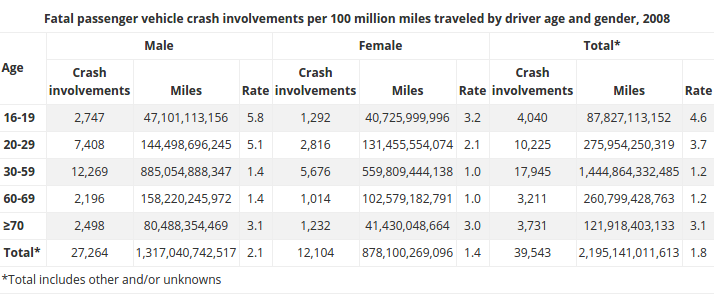Road safety is a passion of mine, and is the driving force behind why I created this blog. I’ve written extensively about car seat selection and safe vehicle choices and technologies, but I’ve also extensively advocated for the need to improve our cultural attitudes toward safe and sustainable transportation in order to make our streets and communities safe for everyone (especially those who can’t or won’t drive, such as children, cyclists, the elderly and disabled, and so on).
This entry, as a result, is part of a series about driving in the United States, and the people on our roads who make such driving (and road use) more or less safe. Today’s focus is on the most dangerous drivers in the United States: young men between the ages of 16 and 29. This is a large and influential demographic in our country, and it’s worth looking into how and why they’re dangerous, and what we can do to make them safer, in order to make the roads safer for everyone.
Which drivers are most likely to be involved in fatal vehicle crashes?

According to an IIHS analysis of USDOT Fatality Analysis Reporting System data, male drivers are universally more likely to be involved in fatal collisions per mile driven than female drivers, as reflected by the 2.1 per 100 million miles traveled rate for male drivers compared to the 1.4 per 100 million miles traveled rate for female drivers. In other words, for every mile driven, a male driver is 50% more likely to be involved in a fatal crash than a female driver. That’s bad enough. But things get even worse when we look at younger drivers.
How dangerous are teenage drivers (male and female)?
Look at the chart closely, and you’ll notice that the two highest rates of fatal crash involvements, and they’re the two highest by a long shot, belong to male drivers. A 16 to 19 year-old male driver is nearly 2x more likely to be involved in a fatal collision than a 16 to 19-year-old female driver. However, a 20 to 29-year-old male is still more than 1.5x more likely to be involved in a fatal collision than a 16 to 19-year-old female driver. The average male driver doesn’t experience a lower rate of fatal crash involvement than the average 16 to 19-year-old female driver until he’s at least 30 years old.
 To put it another way, the average male driver is a greater risk on the road, per mile driven, than any other driver, from the moment he gets his license until the day he turns 30. That’s 14 years of being more dangerous than a senior driver of either gender, and that’s 14 years of being more dangerous than a teenage female driver.
To put it another way, the average male driver is a greater risk on the road, per mile driven, than any other driver, from the moment he gets his license until the day he turns 30. That’s 14 years of being more dangerous than a senior driver of either gender, and that’s 14 years of being more dangerous than a teenage female driver.
This is sobering, but it’s so important to keep in mind. Every day, it’s common to hear talk among people and throughout the news about how dangerous “seniors” are behind the wheel, or how bad “teenagers” are when it comes to taking driving seriously. This paints an incomplete picture of the facts.
While it’s true that there are certainly some poor elderly drivers and that teenage boys and girls are the demographics most likely to be involved in fatal collisions within their genders, a look at the numbers reveals a more accurate picture. And that picture indicates that male teens and young adults are far more likely to be reckless drivers than drivers of any other gender or age group. I’ve written about this before.
How do we make male drivers under 30 safer, more responsible, or at least less dangerous?
That’s a great question, and it’s one with a range of possible answers. For me, one of the most pressing answers involves awareness and education. As I noted above, most people aren’t aware of how often men under 30 are involved in fatal collisions, and many more paint all seniors or teens with too broad of a brush, mistakenly believing they’re the reasons our roads are unsafe.
The truth is, however, that all men are a greater risk at every age than the equivalent female demographic, and that men under 30 are particularly risky drivers. Spreading the word of this truth, from my perspective, is the first step toward creating a culture of safer drivers.
As a male driver, I’ve lived through the two most risky demographics for my gender, and I can easily affirm that my peers didn’t take driving nearly as seriously as it merited, and neither did I more times than I’m proud to admit. But we need to make a change. Too much is at stake on our roads to keep driving the way we do.
Once we start having this discussion, the topic of how to drive safely can then be raised. It’s one the men of this country need to hear.
—
 If you find my information on best practices in car and car seat safety helpful, you can buy my books here or do your shopping through this Amazon link. Canadians can shop here for Canadian purchases. It costs nothing extra to do so, but when you shop through my links, a small portion of your purchase, regardless of what you buy, will go toward the maintenance of The Car Crash Detective.
If you find my information on best practices in car and car seat safety helpful, you can buy my books here or do your shopping through this Amazon link. Canadians can shop here for Canadian purchases. It costs nothing extra to do so, but when you shop through my links, a small portion of your purchase, regardless of what you buy, will go toward the maintenance of The Car Crash Detective.

